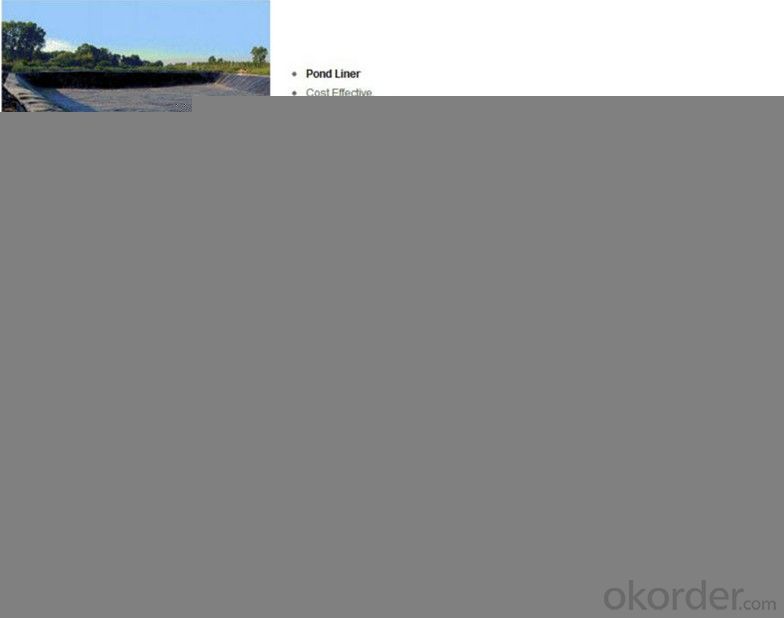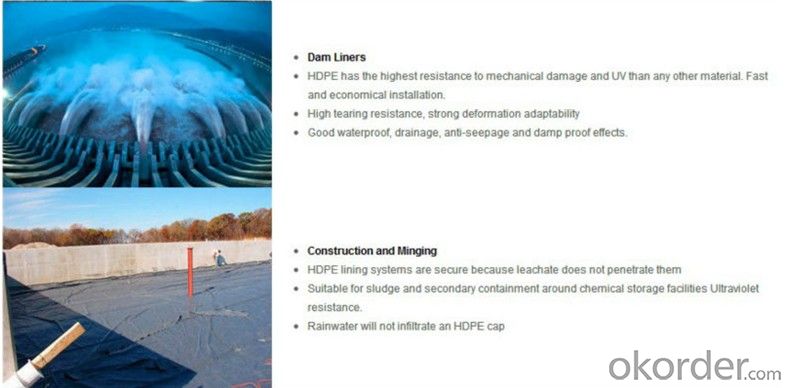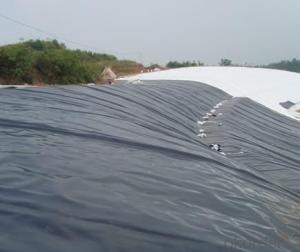HDPE Geomembranes
- Loading Port:
- China Main Port
- Payment Terms:
- TT OR LC
- Min Order Qty:
- -
- Supply Capability:
- -
OKorder Service Pledge
OKorder Financial Service
You Might Also Like
HDPE Geomembranes
Products Description
This product is extruded PE membrane formed by adding anti- oxidant, absorbent of ultraviolet and dyestuff into HDPE or LDPE or EVA and will provide an effective barrier to of liquid
water and water vapor.
Characteristics
·HDPE performs well in mechanical properties ,ageing-resistance , chemical-resistance ,climate- resistance and
resistance to puncture .
·LDPE & EVA feathers great elongation, good flexibility at low temperature, softness and easy
installation.
·ECB ,high-class waterproofing rolls, is formed by combining ethylene polymer with oil-resin.
Products Specification
Name | Thickness(mm) | Width(m) |
HDPE | 0.75-2.5 | 4-8 |
LDPE | 0.2-2.5 | 4-8 |
EVA | 0.2-2.5 | 2-8 |
ECB | 1.0-2.0 | 2-8 |
Features:
1.All physical factors such as anti-draw, anti-tear, and anti-stab meet the requirement of water works, chemicals, tunnels,
and transportation project in most conditions.
2.Good aging, durable performance, and wide temperature range, it can be useful over
thirty years on the condition of -60æ«60æ.
3.Anti-stab and fine friction factors.
4.Canker proof, acid and alkali proof, untoxic.
5.Lower cost per unit area, cost is 1/3«1/2 lower than that of PVC film, glass and cloth.
6.Convevient to install and dependable effect.
Application Rage


- Q:Can a waterproofing membrane be used for bridge decks and roadways?
- Yes, a waterproofing membrane can be used for bridge decks and roadways. Waterproofing membranes are designed to provide a protective layer that prevents water infiltration, which is essential for the long-term durability and performance of bridge decks and roadways. These membranes help to prevent water damage, such as corrosion and cracking, and also protect the underlying structure from moisture-related issues.
- Q:How is the water level rated and how many grades are used?
- 1, roof waterproof level 1: Application: particularly important or waterproof with special requirements of the building; Waterproof layer of reasonable use of life: 25 years; Waterproof layer selection of materials: should use synthetic polymer waterproofing membrane, polymer modified asphalt waterproofing membrane, metal sheet, synthetic polymer waterproof coating, fine stone concrete and other materials; Fortification requirements: three or more than three waterproof fortification.
- Q:Can waterproofing membranes be used on terraces?
- Yes, waterproofing membranes can definitely be used on terraces. In fact, using waterproofing membranes on terraces is highly recommended to protect the structural integrity of the terrace and prevent water damage. Waterproofing membranes act as a barrier, preventing water from seeping into the terrace and causing leaks or cracks. They are commonly used on flat terraces, rooftop terraces, and balconies to ensure that water does not penetrate the surface and cause damage to the underlying structure. Waterproofing membranes are available in various types, such as liquid-applied membranes, sheet membranes, and self-adhesive membranes, providing different options to suit the specific needs and requirements of the terrace. By applying a waterproofing membrane, the terrace can be protected from moisture, UV rays, and other environmental factors, extending its lifespan and ensuring a durable and long-lasting surface.
- Q:Can a waterproofing membrane be applied over cracks or joints in a surface?
- No, a waterproofing membrane should not be applied over cracks or joints in a surface. Cracks or joints in a surface can compromise the integrity of the waterproofing system and allow water to seep through. It is important to properly repair and seal any cracks or joints before applying a waterproofing membrane to ensure effective water resistance.
- Q:Can a waterproofing membrane be used in kitchens?
- Certainly! Kitchens can indeed benefit from the application of a waterproofing membrane. It is strongly advised to employ such membranes in spaces that are susceptible to moisture and water, like kitchens. These specialized membranes are engineered to establish a shield against water, thwarting its infiltration into the foundation and safeguarding it against harm. They are frequently utilized on floors, walls, and even countertops to ensure a tight seal that resists water damage, the growth of mold, and various other complications. Moreover, waterproofing membranes can aid in soundproofing while enhancing the sturdiness and lifespan of kitchen surfaces.
- Q:Can a waterproofing membrane be applied to uneven surfaces?
- Yes, a waterproofing membrane can be applied to uneven surfaces. However, the level of success and effectiveness may vary depending on the severity of the unevenness. It is important to properly prepare the surface by removing any loose debris, filling in large gaps or holes, and smoothening out any high points or ridges. There are also certain types of waterproofing membranes that are more flexible and can conform to uneven surfaces better than others. It is recommended to consult with a professional waterproofing contractor who can assess the condition of the surface and recommend the most suitable waterproofing membrane for the specific unevenness.
- Q:Does a waterproofing membrane have any impact on the appearance of a surface?
- Yes, a waterproofing membrane can have an impact on the appearance of a surface. When applied to a surface, such as a wall or floor, the waterproofing membrane creates a barrier that prevents water or moisture from penetrating the surface. This often involves applying a coating or layer that can alter the texture or sheen of the surface. In some cases, the membrane may cause a slight color change or darken the surface. However, there are also transparent or colorless waterproofing membranes available that do not significantly alter the appearance of the surface. Ultimately, the impact on appearance will depend on the type of waterproofing membrane used and the desired aesthetic outcome.
- Q:How do waterproofing membranes adhere to surfaces?
- Waterproofing membranes adhere to surfaces through a combination of mechanical and chemical bonding. The surfaces must be clean, dry, and free from any loose particles or contaminants before the membrane is applied. In terms of mechanical bonding, many waterproofing membranes have a textured or rough surface that allows for a better grip on the substrate. This texture creates more contact points between the membrane and the surface, increasing the adhesion strength. Additionally, some membranes have a self-adhesive backing that allows them to stick directly to the substrate without the need for additional adhesives. Chemical bonding also plays a crucial role in adhesion. Waterproofing membranes are often made from materials such as modified bitumen, EPDM rubber, or PVC, which have inherent adhesive properties. These materials are designed to create a chemical bond with the substrate, creating a strong and durable seal. In some cases, additional adhesives or primers may be required to enhance the adhesion of the waterproofing membrane. These products are specifically formulated to promote a stronger bond between the membrane and the surface, ensuring long-lasting waterproofing protection. Overall, the adhesion of waterproofing membranes to surfaces is achieved through a combination of mechanical and chemical bonding, along with the use of specialized adhesives or primers when necessary. This ensures that the membrane is securely attached to the substrate, preventing water from penetrating and causing damage.
- Q:Is a waterproofing membrane necessary for all types of construction?
- No, a waterproofing membrane is not necessary for all types of construction. It primarily depends on the location, purpose, and materials used in the construction project. While waterproofing membranes are essential for structures like basements, swimming pools, or buildings in areas prone to heavy rainfall or moisture, they may not be required for every type of construction. Factors such as climate, building design, and intended use should be considered to determine the necessity of a waterproofing membrane.
- Q:What is the difference between polymer waterproofing membrane and cross film waterproofing membrane?
- Quanzhou strong cross-membrane waterproof membrane and polymer waterproofing membrane of the difference, the main component is not the same: strong cross-membrane is a polyethylene film, polymer is a polymer homogeneous film. You can choose Yu Xiang card UFW-C strong cross-membrane reaction bonding waterproofing membrane, Fujian Yu Xiang waterproof material Technology Co., Ltd. is a research and development, production of building waterproof materials and waterproof engineering to undertake the building waterproof system service providers!
1. Manufacturer Overview |
|
|---|---|
| Location | |
| Year Established | |
| Annual Output Value | |
| Main Markets | |
| Company Certifications | |
2. Manufacturer Certificates |
|
|---|---|
| a) Certification Name | |
| Range | |
| Reference | |
| Validity Period | |
3. Manufacturer Capability |
|
|---|---|
| a)Trade Capacity | |
| Nearest Port | |
| Export Percentage | |
| No.of Employees in Trade Department | |
| Language Spoken: | |
| b)Factory Information | |
| Factory Size: | |
| No. of Production Lines | |
| Contract Manufacturing | |
| Product Price Range | |
Send your message to us
HDPE Geomembranes
- Loading Port:
- China Main Port
- Payment Terms:
- TT OR LC
- Min Order Qty:
- -
- Supply Capability:
- -
OKorder Service Pledge
OKorder Financial Service
Similar products
New products
Hot products
Hot Searches
Related keywords




























